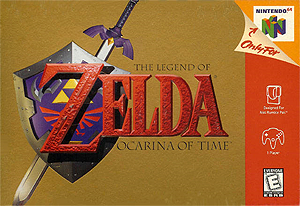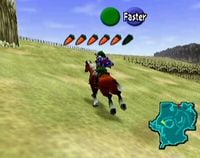The Legend of Zelda: Ocarina of Time: Difference between revisions
m (Byte saving.) |
MisterDrBob (talk | contribs) No edit summary |
||
| Line 17: | Line 17: | ||
|modes = Single-player | |modes = Single-player | ||
|ratings = ESRB: E, E10+ (''3D'')<br>ELSPA: 3+<br>OFLC: G8+<br>PEGI: 7+ (GameCube), 12+ (Wii, ''3D'') | |ratings = ESRB: E, E10+ (''3D'')<br>ELSPA: 3+<br>OFLC: G8+<br>PEGI: 7+ (GameCube), 12+ (Wii, ''3D'') | ||
|platform = Nintendo 64, Nintendo GameCube, iQue, Virtual Console, Nintendo 3DS | |platform = Nintendo 64, Nintendo GameCube, iQue, Virtual Console, Nintendo 3DS, Nintendo Switch Online Expansion Pass | ||
|media = | |media = | ||
|requirements = | |requirements = | ||
Revision as of 19:51, January 5, 2022
| The Legend of Zelda: Ocarina of Time | |
|---|---|
 
Box cover for the North American version of The Legend of Zelda: Ocarina of Time | |
| Developer(s) | Nintendo EAD |
| Publisher(s) | Nintendo |
| Designer(s) | Shigeru Miyamoto (producer/director) |
| Engine | Derivative of Super Mario 64 engine |
| Picture format | 4:3 Aspect ratio |
| Released | Nintendo 64 Nintendo GameCube iQue Virtual Console |
| Genre(s) | Action-adventure |
| Mode(s) | Single-player |
| Ratings | ESRB: E, E10+ (3D) ELSPA: 3+ OFLC: G8+ PEGI: 7+ (GameCube), 12+ (Wii, 3D) |
| Platform(s) | Nintendo 64, Nintendo GameCube, iQue, Virtual Console, Nintendo 3DS, Nintendo Switch Online Expansion Pass |
| Input methods | Gamepad |
| Article on Zelda Wiki | The Legend of Zelda: Ocarina of Time |
The Legend of Zelda: Ocarina of Time (ゼルダの伝説 時のオカリナ, The Legend of Zelda: Ocarina of Time), commonly abbreviated as OoT, is the fifth game in The Legend of Zelda series. It was the first The Legend of Zelda title to feature 3D graphics, and the first of two Zelda titles for the Nintendo 64, the other being its direct squeal, The Legend of Zelda: Majora's Mask. It is often considered to be the best game in the Zelda franchise, and is even considered by many to be the best game of all time. The game was remade for Nintendo GameCube and Nintendo 3DS, the latter calling the remake The Legend of Zelda: Ocarina of Time 3D.
This game appears as a Masterpiece in Super Smash Bros. Brawl. It can be played for 300 seconds and has save files for beginning of Young Link and Adult Link sections. It must be unlocked by using Toon Link in 10 brawls.
In the Super Smash Bros. series
Fighters
Link's appearance is based on this game in both Super Smash Bros. and Super Smash Bros. Melee. The same applies to Zelda's appearance in Melee, and Ganondorf in Melee and Ultimate. Sheik and Ganondorf debuted in this game. Ganondorf attacked Zelda, and she disguised herself as Sheik in order to escape him. Young Link is based on Link's younger version from this game.
Stages
Hyrule Castle in Super Smash Bros., Super Smash Bros. 4 and Super Smash Bros. Ultimate is based on the Ocarina of Time design, although it does incorporate elements from earlier games. It is the place where Zelda lives. Gerudo Valley comes from the 3DS remake of this game.
Items
The Bunny Hood and Deku Nut come from this game. One of the side missions in the game requires Young Link to sell various masks to the citizens of Hyrule. Young Link finds the Running Man in Hyrule Field and sells the Bunny Hood to him. Once Young Link sells the Bunny Hood, he is able to borrow it from the Happy Mask Salesman at anytime. Deku Nuts can be used to stun certain enemies in the game.
Enemies
ReDeads first appeared in this game and appear as enemies in Adventure Mode and Smash Run. Octoroks, Like Likes, Bubbles, Peahats, and Stalfos didn't debut in this game, but use their designs from this game in the single-player modes they appear in. (The exception being Octoroks in Smash Run, who use their Skyward Sword design).
Music
"Saria's Song", "Ocarina of Time Medley", "Hyrule Field Theme", "Song of Storms", "Gerudo Valley (Brawl)", "Gerudo Valley (3DS)" and "Saria's Song / Middle Boss Battle" come from this game. "Ocarina of Time Medley" is a medley of several music pieces from this game. It starts as a remix of Zelda's Lullaby, then transitions into Sun's Song, a small extract of Minuet of Forest and Bolero of Fire, all remixed on an ocarina to be reminiscent of how Link would play these songs on the Ocarina of Time. A very small part is taken from the Boss introduction theme, remixed on a piano, before reverting back to the ocarina to remix the Windmill Hut, which is the basis for the Song of Storms, and Lon Lon Ranch, which is the basis for Epona's Song. These sections are classed as remixes of Windmill Hut and Lon Lon Ranch respectively, because Link never played the full versions of these songs within the Song of Storms and Epona's Song. After this, the arrangement switches to a full orchestra in order to remix the Song of Time and Saria's Song. The Saria's Song remix could be considered a remix of The Lost Woods, as under normal circumstances, Link would not play the full song on his ocarina, but if he plays the piece to Darunia, Saria's Song will be extended. After Saria's Song ends, the song will loop, reverting back to ocarina-based remixes. "Hyrule Field Theme" a remix of the theme that plays on Hyrule Field during the daytime. "Song of Storms" is for the most part a remix of The Windmill Hut theme, the inspiration behind the Song of Storms, but this arrangement also features an original interlude, the music that plays in cutscenes involving Ganondorf, and the Serenade of Water. "Gerudo Valley (Brawl)" is a direct port of the music that plays when Link explores Gerudo Valley and Gerudo's Fortress. "Gerudo Valley (3DS)" is a remix of the previously mentioned theme. "Saria's Song / Middle Boss Battle" is a medley of the similiarly named songs.
| Masterpieces in Super Smash Bros. Brawl | |
|---|---|
| Starter games | Ice Climber · Kid Icarus · Kirby's Adventure · Star Fox 64 · Super Mario Bros. · Super Metroid · The Legend of Zelda |
| Japan-only games | EarthBound · Fire Emblem: Mystery of the Emblem |
| Unlockable games | Donkey Kong · F-Zero · Super Mario Bros. 2 · Super Mario World · The Legend of Zelda: Ocarina of Time |

